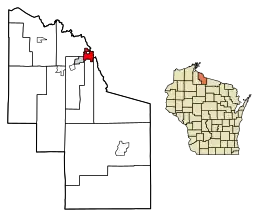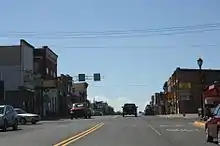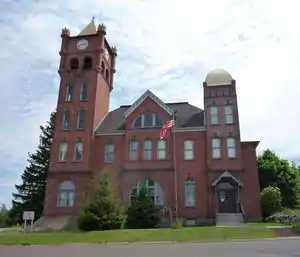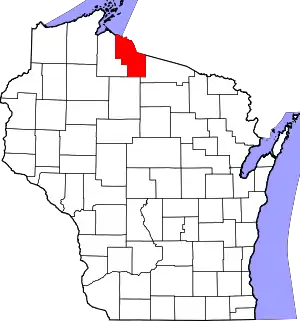Hurley, Wisconsin
Hurley is a city in and the county seat of Iron County, Wisconsin, United States. The population was 1,547 at the 2010 census. It is located directly across the Montreal River from Ironwood, Michigan.
Hurley, Wisconsin | |
|---|---|
 Silver Street | |
 Location of Hurley in Iron County, Wisconsin. | |
| Coordinates: 46°27′1″N 90°11′23″W | |
| Country | |
| State | |
| County | Iron |
| Area | |
| • Total | 3.38 sq mi (8.76 km2) |
| • Land | 3.23 sq mi (8.37 km2) |
| • Water | 0.15 sq mi (0.39 km2) |
| Elevation | 1,496 ft (456 m) |
| Population | |
| • Total | 1,547 |
| • Estimate (2019)[4] | 1,436 |
| • Density | 444.31/sq mi (171.56/km2) |
| Time zone | UTC-6 (Central (CST)) |
| • Summer (DST) | UTC-5 (CDT) |
| Zip Code | 54534 |
| Area code(s) | 715 & 534 |
| FIPS code | 55-36525 |
| GNIS feature ID | 1566822 |
| Website | hurleywi |
History
Hurley is located on the Montreal River, the border between Wisconsin and the Upper Peninsula of Michigan. Hurley and adjacent Gile were lumber towns on the Wisconsin side together with the mining town of Montreal, while on the Michigan side, from west to east, were mining towns of Ironwood, Bessemer and Wakefield, all dependent upon the extraction of iron ore from the Gogebic (Penokee) Range during the 19th and early 20th centuries.
Hurley took its name from M. A. Hurley,[5] a prominent attorney of Wausau who won a lawsuit for the Northern Chief Iron Company in 1884. The compensation for winning the suit was that he asked for no fee but only requested that the town involved in the case be named after him. The full name "Glen Hurley" was used for one year, but in 1885, the first name was dropped and the community became known as Hurley.
Henry Meade was the first mayor of Hurley, Wisconsin. John Ankers opened Hurley's first saloon and served as Hurley's first town clerk, first justice of the peace, and first fire chief. Hurley was a known gangster resort haven for mobsters in the twenties and thirties.
In early November 1887, ten people were killed in a fire that started in a three-story theater and spread to other structures.[6]
The Gogebic Range Directory of 1888 states: "During the past summer, Hurley was twice visited by terrible fires. The first occurred of June 28 and the second on July 9. These destroyed almost the entire business portion of the city, and at first it was thought that they would prove a crushing blow to its prosperity, but later events have proven that they were blessings in disguise. The wonderful pluck and energy of its businessmen were fully demonstrated when they at once began the erection of fine brick buildings in the place of the wooden ones destroyed. The result has been that the burned portion has been rebuilt with brick and stone, making them nearly fireproof. And Silver Street is one that a much larger city could well be proud of."
Historic locations
The Iron Exchange Bank of Hurley, was the oldest bank of the Gogebic Range. It was organized on November 26, 1885. Dr. J.C. Reynolds, the bank's first president, and his brother, W. S. Reynolds, the bank's first cashier, were the prime movers in the organization of the institution. Associated with them in the organization were John E. Burton, Alvin E. Tyler, Edward Ryan, Nathaniel J. Moore, James A. Wood, and Shepherd Homans, all men prominent in the mining industry in the area in the early days. By 1925, when it celebrated its 40th anniversary, it had withstood all financial depressions.
The first meat market in Hurley was kept by Ilsey and Knox and was opened in 1885.
The first newspaper in Hurley was the Montreal River Miner which was first published on October 8, 1885. After absorbing the Iron County News in 1950 the two papers names were merged to form the Iron County Miner which is still published as a weekly.[7]
The first hotel was located at the corner of Second Avenue and Silver Street in a log building, with James Guest as the first landlord. It was far from a pretentious affair but answered the purpose and furnished food and shelter for many a pioneer and miner in its day.
The Burton House was an immense four-story frame hostelry, which was a famous gathering place in the latter part of the 19th century. John E. Burton erected the building in 1865. A mining speculator, his original wealth came from the iron range. Later he established offices in New York City and bought up other vast mining interests in Mexico and South America. The Burton Hotel contained 100 rooms, a ballroom, dining room, café, and clubrooms, all highly decorated and furnished with the best of the woodworkers’ art of the time, and equipped with the best furniture. The Burton Hotel cost $35,000 to construct, and the furniture cost Burton $10,000. Many noteworthy people stayed at the Burton House. Grover Cleveland registered at the Burton House Saturday, October 5, 1889. By that time he had already served one term as president of the United States. In 1889 when he was in Hurley, he was a New York lawyer. He was elected to the presidency again in 1892.
On 24 February 1961, a Boeing B-47 Stratojet bomber crashed near the town, killing all four aboard.[8]
Geography
Hurley is located at 46°27′1″N 90°11′23″W (46.450361, -90.189802).
According to the United States Census Bureau, the city has a total area of 3.58 square miles (9.27 km2), of which 3.42 square miles (8.86 km2) is land and 0.16 square miles (0.41 km2) is water.[9]
It is across the state border and the Montreal River from Ironwood, Michigan, both cities located in the Gogebic Range.
Climate
Hurley has a cool humid continental climate (Köppen Dfb), with long, cold winters and short, mild summers. In an average year the temperature drops below 32 °F (0 °C) on 192 days, and below 0 °F (-17.8 °C) on 40 days. Hurley is also one of the snowiest cities in the United States with an average of over 160 inches of snow per year due to Lake-effect snow from nearby Lake Superior.
| Climate data for Hurley, Wisconsin | |||||||||||||
|---|---|---|---|---|---|---|---|---|---|---|---|---|---|
| Month | Jan | Feb | Mar | Apr | May | Jun | Jul | Aug | Sep | Oct | Nov | Dec | Year |
| Record high °F (°C) | 49 (9) |
58 (14) |
72 (22) |
84 (29) |
88 (31) |
97 (36) |
98 (37) |
93 (34) |
90 (32) |
87 (31) |
72 (22) |
59 (15) |
98 (37) |
| Average high °F (°C) | 19.1 (−7.2) |
25.5 (−3.6) |
35.5 (1.9) |
49.0 (9.4) |
64.5 (18.1) |
72.6 (22.6) |
76.3 (24.6) |
74.5 (23.6) |
64.8 (18.2) |
52.9 (11.6) |
36.0 (2.2) |
23.9 (−4.5) |
49.6 (9.7) |
| Daily mean °F (°C) | 9.5 (−12.5) |
14.6 (−9.7) |
25.6 (−3.6) |
39.0 (3.9) |
52.6 (11.4) |
61.5 (16.4) |
65.9 (18.8) |
64.4 (18.0) |
55.5 (13.1) |
44.1 (6.7) |
29.0 (−1.7) |
15.7 (−9.1) |
39.8 (4.3) |
| Average low °F (°C) | −0.2 (−17.9) |
3.7 (−15.7) |
15.7 (−9.1) |
28.9 (−1.7) |
40.6 (4.8) |
50.3 (10.2) |
55.5 (13.1) |
54.2 (12.3) |
46.2 (7.9) |
35.2 (1.8) |
22.0 (−5.6) |
7.5 (−13.6) |
30.0 (−1.1) |
| Record low °F (°C) | −31 (−35) |
−36 (−38) |
−31 (−35) |
−1 (−18) |
20 (−7) |
24 (−4) |
35 (2) |
35 (2) |
26 (−3) |
9 (−13) |
−9 (−23) |
−24 (−31) |
−36 (−38) |
| Average precipitation inches (mm) | 2.19 (56) |
1.23 (31) |
1.90 (48) |
2.08 (53) |
2.99 (76) |
3.88 (99) |
3.62 (92) |
3.32 (84) |
3.05 (77) |
3.30 (84) |
3.35 (85) |
2.23 (57) |
33.14 (842) |
| Average snowfall inches (cm) | 42.4 (108) |
21.4 (54) |
19.0 (48) |
7.3 (19) |
1.5 (3.8) |
0 (0) |
0 (0) |
0 (0) |
0.4 (1.0) |
4.9 (12) |
30.1 (76) |
38.3 (97) |
165.3 (420) |
| Source: Midwestern Regional Climate Center[10] | |||||||||||||
Demographics
| Historical population | |||
|---|---|---|---|
| Census | Pop. | %± | |
| 1920 | 3,188 | — | |
| 1930 | 3,264 | 2.4% | |
| 1940 | 3,375 | 3.4% | |
| 1950 | 3,034 | −10.1% | |
| 1960 | 2,763 | −8.9% | |
| 1970 | 2,418 | −12.5% | |
| 1980 | 2,015 | −16.7% | |
| 1990 | 1,782 | −11.6% | |
| 2000 | 1,818 | 2.0% | |
| 2010 | 1,547 | −14.9% | |
| 2019 (est.) | 1,436 | [4] | −7.2% |
| U.S. Decennial Census[11] | |||
2010 census
As of the census[3] of 2010, there were 1,547 people, 771 households, and 360 families residing in the city. The population density was 452.3 inhabitants per square mile (174.6/km2). There were 1,032 housing units at an average density of 301.8 per square mile (116.5/km2). The racial makeup of the city was 97.5% White, 0.1% African American, 0.8% Native American, 0.2% Asian, 0.1% from other races, and 1.2% from two or more races. Hispanic or Latino of any race were 0.8% of the population.
There were 771 households, of which 20.6% had children under the age of 18 living with them, 31.1% were married couples living together, 10.0% had a female householder with no husband present, 5.6% had a male householder with no wife present, and 53.3% were non-families. 47.1% of all households were made up of individuals, and 23.1% had someone living alone who was 65 years of age or older. The average household size was 1.89 and the average family size was 2.66.
The median age in the city was 49 years. 16.2% of residents were under the age of 18; 6.9% were between the ages of 18 and 24; 20.5% were from 25 to 44; 30.3% were from 45 to 64; and 26.1% were 65 years of age or older. The gender makeup of the city was 47.3% male and 52.7% female.
2000 census
As of the census of 2000, there were 1,818 people, 830 households, and 458 families residing in the city. The population density was 577.3 people per square mile (222.8/km2). There were 1,025 housing units at an average density of 325.5 per square mile (125.6/km2). The racial makeup of the city was 97.36% Caucasian, 0.06% African American, 1.38% Native American, 0.11% Asian, 0.17% Pacific Islander, and 0.94% from two or more races. Hispanic or Latino of any race were 0.88% of the population. 30.3% were of Italian, 20.4% Finnish, 9.7% German and 9.3% Polish ancestry.
There were 830 households, out of which 20.6% had children under the age of 18 living with them, 41.7% were married couples living together, 9.3% had a female householder with no husband present, and 44.8% were non-families. 39.9% of all households were made up of individuals, and 20.8% had someone living alone who was 65 years of age or older. The average household size was 2.06 and the average family size was 2.72.
In the city, the population was spread out, with 18.2% under the age of 18, 8.6% from 18 to 24, 27.0% from 25 to 44, 19.7% from 45 to 64, and 26.6% who were 65 years of age or older. The median age was 43 years. For every 100 females, there were 90.2 males. For every 100 females age 18 and over, there were 86.2 males.
The median income for a household in the city was $24,821, and the median income for a family was $33,000. Males had a median income of $27,717 versus $17,750 for females. The per capita income for the city was $14,554. About 11.0% of families and 14.7% of the population were below the poverty line, including 18.6% of those under age 18 and 15.1% of those age 65 or over.
Transportation

| U.S. 2 runs west to Ashland, Wisconsin and Duluth, Minnesota, intersecting U.S. 51 at the Michigan/Wisconsin border at Ironwood and then goes east to Iron Mountain. | |
| U.S. 51 northbound US 51 terminates at Hurley. Southbound, US 51 routes to Wausau, Wisconsin; where it intersects with Interstate 39. | |
| WIS 77 starts just at the state line in Hurley and travels southwest. |
Hurley was served by the Chicago & North Western Flambeau Line with the Flambeau 400 train between Chicago and Ashland.
Media
WHRY-AM and WUPM-FM are the two local radio stations, along with stations from Ironwood, Michigan.
Recreation
Hurley is known for its ATV Hurley Rally held on Memorial Day weekend, a Pumpkin ATV rally held the second weekend of October, and the Red Light Snowmobile Rally. Both attract thousands of visitors to the area each year. At the 2005 ATV rally, a new Guinness World Record was set for the largest ATV parade, with 687 participants.
Popular culture

A fictionalized version of Hurley was the subject of Edna Ferber's 1934 novel Come and Get It. Ferber did most of her research for the novel while staying at Hurley's Burton House hotel.[12]
Ralph Capone, the older brother of famed Chicago mobster Al Capone, died in Hurley in 1974.[13]
Notable people
- Len Calligaro, football player
- Ralph Capone, former Public Enemy No. 3 and older brother to gangster Al Capone.
- Chester P. Emunson, Michigan State Representative
- Everis A. Hayes, U.S. Representative from California
- Hyman M. Mark, Wisconsin State Representative
- Alvin O'Konski, U.S. Representative
- Frank Olson, bio-weaponeer who died under contentious circumstances
- Albert L. Osborn, Wisconsin State Representative
- Alex J. Raineri, Wisconsin State Representative
- Frank Rooney, MLB player
- Joseph Sullivan, an FBI major case inspector who led the investigation into the murders of Chaney, Goodman, and Schwerner in 1964, depicted in the movie Mississippi Burning
- Richard C. Trembath, Wisconsin State Representative and jurist
- John P. Varda, Wisconsin State Representative and Wisconsin State Circuit Judge
- Sherman W. Wade, Wisconsin State Senator
- Earl W. Warren, Wisconsin State Representative
References
- "2019 U.S. Gazetteer Files". United States Census Bureau. Retrieved August 7, 2020.
- "US Board on Geographic Names". United States Geological Survey. 2007-10-25. Retrieved 2008-01-31.
- "U.S. Census website". United States Census Bureau. Retrieved 2012-11-18.
- "Population and Housing Unit Estimates". United States Census Bureau. May 24, 2020. Retrieved May 27, 2020.
- Gannett, Henry (1905). The Origin of Certain Place Names in the United States. Govt. Print. Off. pp. 164.
- "Hurley, WI Theater and Buildings Fire, Nov 1887". Eau Claire Daily Free Press. 13 July 1887. Retrieved 25 July 2020.
- Guide to Wisconsin Newspapers-1833-1957; compiled by Donald E. Oehlerts
- "Hurley, WI Air Force Bomber Crash, Feb 1961". The Herald (Provo Utah). United Press International. 26 February 1961. Retrieved 25 July 2020.
- "US Gazetteer files 2010". United States Census Bureau. Archived from the original on 2012-01-24. Retrieved 2012-11-18.
- "Climate of the Midwest: Climate Summaries". Midwestern Regional Climate Center. 2012. Archived from the original on 2014-06-30. Retrieved on July 19, 2012.
- "Census of Population and Housing". Census.gov. Retrieved June 4, 2015.
- Hunts UP Guide
- "Ralph Capone, 81". The New York Times, November 24, 1974. Retrieved September 30, 2018.
External links
| Wikimedia Commons has media related to Hurley, Wisconsin. |

